Now, this is a convertible! Hats off to Packard who went down swinging so late in their game – what a shame! In 1954, the year that this convertible was built, Packard still had a lively line-up but the walls were slowing closing in on this storied Detroit auto manufacturer. With that in mind, let’s take a look at one of their more pleasing models in the form of this 1954 standard convertible. It is located in Cincinnati, Ohio and is available, here on eBay for a current bid of $7,000 with fourteen bids tendered so far.
Some might say that this Packard is a “Cavalier” model as that’s what the standard convertible was called in 1953 but for ’54, the Cavalier name was assigned to a four-door sedan only, and this model was simply known as a Packard even though it shares the Cavalier’s trim but not its longer wheelbase. According to Packard’s ’54 sales brochure, models were basically broken down into two groups, the standard Packard and the shorter Clipper. Standard Packards included the Patrician, Caribbean, the Pacific, the aforementioned Cavalier, and the standard convertible. The Clippers, which were referred to as medium-priced cars, offered two and four-door sedans as well as the two-door “Panama” hardtop. Total production output of about 30K units put Packard in sixteenth place (number one Ford cranked out 1.1M that year), and was a nadir. Volumes covered nicely in ’55 but then slid into the abyss starting in ’56 through the end of Packard production in ’58.
The story on this claimed 66K mile example is that it’s from an estate sale and it has been garage-kept and “very” well maintained. The seller adds, “It has a straight, mostly solid body – with a good frame, floor and trunk. The rocker panels and lower doors have been poorly patched about 40 years ago when the car was refinished“. For the most part, the images aren’t granular enough to note the repair but there is one of the driver’s side rocker/lower quarter panel that is showing some lumps. The chrome is considered to be “mostly good” and the top is stated as “driver quality” which is an unusual description for a folding top. From what can be seen, it looks fine other than the lower corners of the rear window.
Under the hood is a 212 HP, 359 CI in-line straight eight, flathead engine. It is said that the flathead engine design was one element of Packard’s downfall as the world, by ’54, had moved to OHV V8’s and Packard was still laboring in the past. This engine will start but the car has not been driven in six years. There is an “Ultramatic Drive” automatic transmission in place.
Back to that “driver quality” comment, that descriptor has been leveled at the interior too though I’d say driver quality or not, it looks fine. Admittedly the interior details, other than the seating upholstery and carpet, are light but it is clean and orderly and doesn’t appear to need any attention. The instrument panel is a bit restrained for the era but it is still attractive and functional in its layout and the gauges appear to be clear.
Fallen flags, especially when they have the cachet of a Packard, are always a nice find and this one is no exception. Agreed, the body repair, from what can be seen isn’t great but this stylish convertible still has an impressive bearing about itself. This Packard will be going to a new home and someone will get quite a bit of enjoyment from this late installment of a car that sold itself with the tagline, “Ask the man who owns one”, wouldn’t you agree?

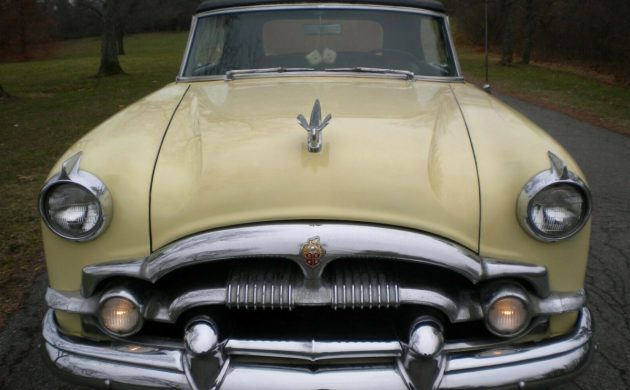
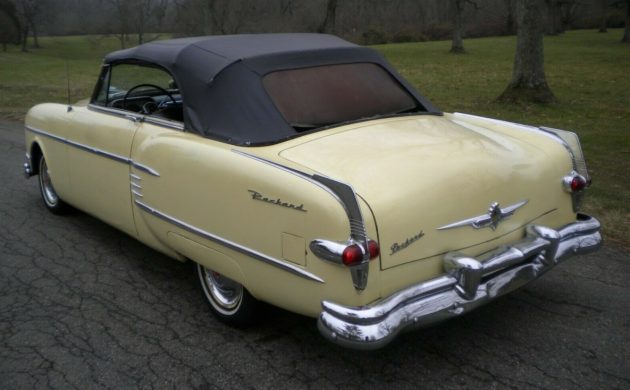
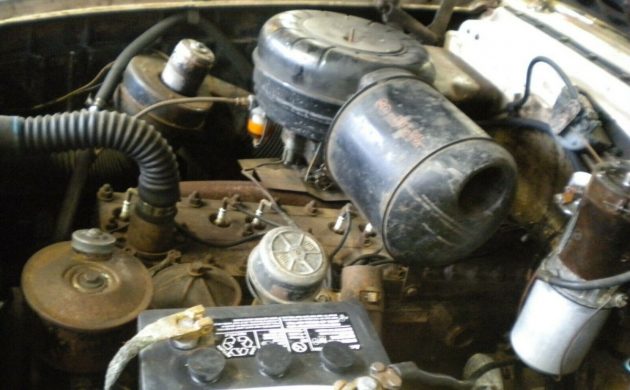
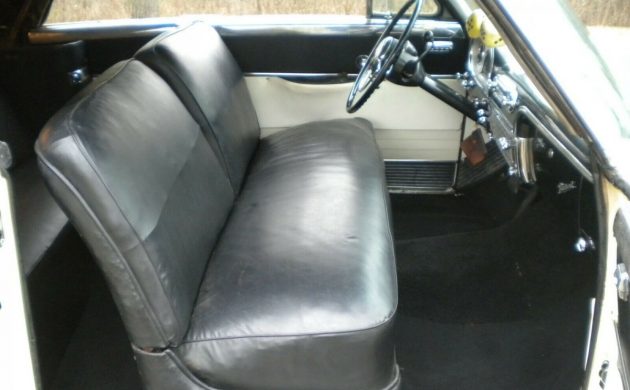
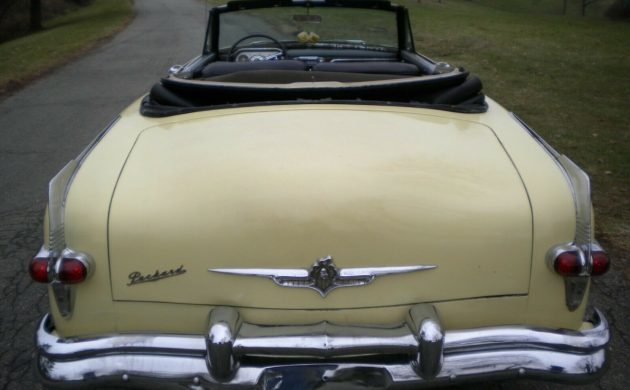
That’s a good looking car, now I want one.
Get in line Andy. I saw it first. :)
“Santa baby, a ’54 convertible too…yellow’ll do…”
I don’t think it had 212 horse power,more like 150 ,yes Wikipedia may say 212 but other places say 150.
I didn’t use Wikipedia, I used the attached 1954 Packard Sales Brochure – it states 212 HP.
JO
Sorry bout that,did not think any flathead 8 made that much power.
No worries Don, Wikipedia is an OK source, especially if nothing else is available, but it does have its inaccuracies. I prefer to use a myriad of other sources and then look for consistency of metrics/stats across those sources.
JO
I sold a 4 door version of this, and the aluminum headed 359 was the most powerful engine in a production car in 1954. Comments about the transmission sucking up power are true, and the fact that it weighs 2 tons or more. I loved that engine and it was smooooooth.
Tip of the hat to Jim, for his kind opening words, but truth be known, the ’54 Packard, in any model, was still a warmed over prewar offering. The motor, stout as it may be, was from the 30’s, the automatic from late 40’s, one of the 1st, and was updated to the “Twin Ultramatic”( from none other than John DeLorean) in ’55, so this was still a slushbox, adequate, but not for a V8 to come. If anyone could glitz up a 20 year old design, this car was it, and still mighty impressive, and you can say, you have one of the last “old style” cars, as styling only went up from these. Too bad Packard wasn’t part of that. The new ’55’s showed, it could have been done. For the record, the 359 featured here, did put out over 200 hp( on paper) with hyd. lifters, 4 barrel, higher compression, but the trans sucked much of it, and an Olds, or even a new Ford V8 could eat it for lunch. The straight 8 had met it’s demise, and Packard milked it to the end. Still a neat find.
Sure Howard, but did the buyer of this really need or want power? The straight eight was stout and reliable, put out more then enough power. Packard buyers wanted luxury and prestige, that card had this all day. Of course, the fact they went belly up might shed some evidence in the opinion that power mattered, though I think there was more to it. Of course, Packard made a “killing” off those war bucks, wonder who squandered that?
This car is a great reason not to buy the ’75 Buick further up. About as nice a design as you can get and much better looking than a good number of cars in the era. Nice car.
I worked on one just like this in the early ’90’s. Owner kept it for a short time then I drove it from Anahiem to Palm Springs to auction. Awesome driver too! Smoooth like a Packard! Never forget it.
Oh man, what a beauty! The straight 8 may not have the horsepower the Oldsmobiles of this era had, but there was plenty of torque to pull this land yacht down the road in stile. My ’52, equipped with a 327 straight 8, moves along just fine with today’s traffic and floats down the highway like a dream! I’m sure this car’s power-plant can do the same, if not better. It’s a classy cruiser not a racer, after all. If I had the room, I’d not hesitate attempting to get it.This could be someone’s dream machine for sure!
Snow tire spare = death by rust cancer. No underneath pics.
Well it does say it has patches and repairs to the body.
There’s always Debbie downers, but this is a fine automobile in drop top form. It’s always going to be a head turner. I would be proud to own this beauty.
Borrowed a 15 year old ’52 Pontiac convertible from a college mate to make a round trip to Oregon and back from north Mississippi. Big flathead straight 8 just hummed smoothly at 80 mph and ate up the Rocky Mountains in the process. This Packard can’t be too far away from being the same.
I’ve owned a 1953 and a 1951 example of Packard’s convertible. I’ve worked on hundreds of them over the last 50+ years. Still Own a ’48 Super Eight Convertible.
This example is missing the aluminum cylinder head. From a purely driving situation, that’s a good thing. If one wants to restore it, the car needs a new correct head. The seats have been covered in a bland early vinyl seat cover set, and probably because the original full leather seats are shot.
Based on the multiple 1950s Packard convertibles awaiting restoration that were sold at the Lou Abelov collection of Packards at auction a few weeks ago, This car is fast approaching it’s current value. 1954 Caribbeans [in need of restoration, but complete] sold for a lot less at the Abelov sale.
Currently bid at $15,975. Still a great deal, in my opinion.
My old boss at the hearse dealership told me that in the way past he had a vintage Packard hearse. He told me it was automatic, but the transmission went out on it. He told me the automatic transmissions in those were problematic, so if what he said was true (I have no clue), then I would be cautious with this one.
I would want the straight shift myself anyhow.
Stevieg,
The Packard Ultramatic was a very reliable automatic transmission when compared to the competition. In normal use with typical Packard automobiles, failure rates were quite low. It wasn’t until the company was pressured into introducing a newer version called the Twin-Ultramatic in the late 1954 cars, that problems emerged. That transmission had serious teething problems having been rushed into production, especially when drivers put it in the wrong drive gear [there were 2] resulting in premature wear. Had the company been able to continue it’s Detroit line of cars, within a couple of years the problems would have been worked out. Today, the Twin-Ultramatic transmission, when properly cared for and the proper updates performed during a rebuild, is very reliable.
Now as for the hearse you describe: The Henney Packard commercial cars were very heavy, especially when tasked with carrying a casket and contents, something that traditionally takes 6 men to carry. Sadly, the Packard Ultramatic was not designed with these heavy cars in mind. Few Henney-Packard cars had Ultramatic transmission, so the hearse you heard about would be one of the few equipped in that manner.
I always preferred my Packards with stick and overdrive, not because of reliability issues with the Ultramatic, but simply because I like stick and overdrive in all my cars.
Good to know. As long as it is not a hearse or limo, this vintage automatic is not so bad.
I too prefer a stick shift, so I would still look for the handshaker.
Again, thank you for the lhandshakes.
This is why I love this website…you can always learn something new here!